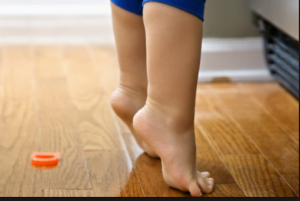Should I Be Concerned if My Child is Toe Walking?
By: Alex Beschorner, teli Occupational Therapist and Cindi Hobbes, teli Physical Therapist
Why do kids walk on their tip toes?
Is toe walking something to be concerned about?
 Toe walking or walking on the toes or the ball of the foot, is common in children who are beginning to walk. As a child progresses, they typically will grow out of this pattern as they gain confidence and stability. If a child continues to occasionally toe walk as an older toddler, it is likely out of habit. Provided that the child is reaching the normal developmental milestones for their age, there is no reason for concern.
Toe walking or walking on the toes or the ball of the foot, is common in children who are beginning to walk. As a child progresses, they typically will grow out of this pattern as they gain confidence and stability. If a child continues to occasionally toe walk as an older toddler, it is likely out of habit. Provided that the child is reaching the normal developmental milestones for their age, there is no reason for concern.
However, if toe walking continues past age 2, it is recommended that a health care professional be consulted, and Early Intervention Services can provide help! Early Intervention therapies, particularly physical and occupational therapies, can help to improve balance, achieve a healthy walking pattern, and reduce the risk of injury to joints and muscles as your child develops their motor skills.
What causes a child to toe walk?
Health care professionals don’t fully understand why some children who are otherwise developing as expected walk on their toes and others don’t. There are several theories including heredity (an inherited pattern of walking) and gender, as toe walking is more common in boys rather than girls. However, there are some underlying conditions that may also cause a child to toe walk and a trained professional can help screen for them. These conditions include:
- Tightness in the Achilles tendon which prevents a child’s heel from resting flat on the floor.
- Sensory issues such as oversensitivity to the feeling of different surfaces on a child’s feet or a child’s need to feel increased pressure in their feet and joints.
- Muscle tension and motor control issues caused by neurological conditions such as muscular dystrophy (muscle weakness) or cerebral palsy (muscle tightness).
- There is a higher than average occurrence of toe-walking in children with Autism Spectrum Disorder. This may be related to the above sensory issues being more prevalent in children with ASD.
When should I be concerned?
In most cases, toe walking is a temporary stage and not concerning. From 12 – 18 months, children explore different movements and learn about their muscles and how they work. If toe walking does not resolve by 2 years of age, it is recommended that parents seek further evaluation from their health care provider for access to Early Intervention Services. The red flags you may see in a child include:
- Inability to stand still on flat feet, resulting in the child remaining in constant motion, resembling dancing.
- Limited ankle flexibility such that the child is stuck in toe pointed position or they cannot bring their toes toward their shin.
- Unable to squat with feet flat on the floor, with the shin moving forward over the ankle.
- Awkward walking pattern (may be associated with pain).
What can I do to address toe walking in my child?
Once you have discussed your child’s toe walking with your health care provider, Early Intervention Services may help. Over numerous years working with children who walk on their toes, teli occupational and physical therapists have found several Early Intervention activities to be very helpful. The key is to make the activities fun and to incorporate them into your daily routine. This helps to create “muscle memory” and your child will learn to use their new walking skills throughout the day. The following are some activity suggestions:
- Encourage funny animal walks, such as a duck or a penguin, that require the child to bring toes up and hit the ground with the heel first on each step.
- Provide consistent verbal reminders like “flat feet!” or “feet on the ground!” or “heels down!”
- Consider shoes that help support the heel and make toe walking more difficult, such as ankle high boots or hi-top sneakers.
- Have your child push or pull a lightly loaded laundry basket or shopping cart to strengthen leg muscles and reinforce heel to toe movement.
- Jump with your child on a hard surface so that the foot naturally comes down flat.
For children with sensory issues, modifying the environment can help them gradually adapt to their sensory challenges. These are a few suggestions:
- Introduce different textures to your child’s feet to begin to “desensitize” them. Include different textures like soft (cloth, carpet, towel), hard (wood, tile, linoleum, concrete), scratchy (grass, wool, burlap), and bumpy (textured balls, walking on gravel with shoes on).
- Provide deep pressure to their feet through a gentle but firm squeeze or the use of tight, seamless socks.
- Provide pressure to the bottom of their feet by having your child push their feet on the wall or use your hands to gently push against the bottom of their feet. This is a great activity to do during diaper changes.
Moving from toe walking to walking with their entire foot may take some time but is an important “step” for your child’s future. This transition will improve your child’s balance and help them gain confidence – both physically and socially.
If you have questions regarding your child’s development, Early Intervention can help! Call us at 412-922-8322 to get started!


